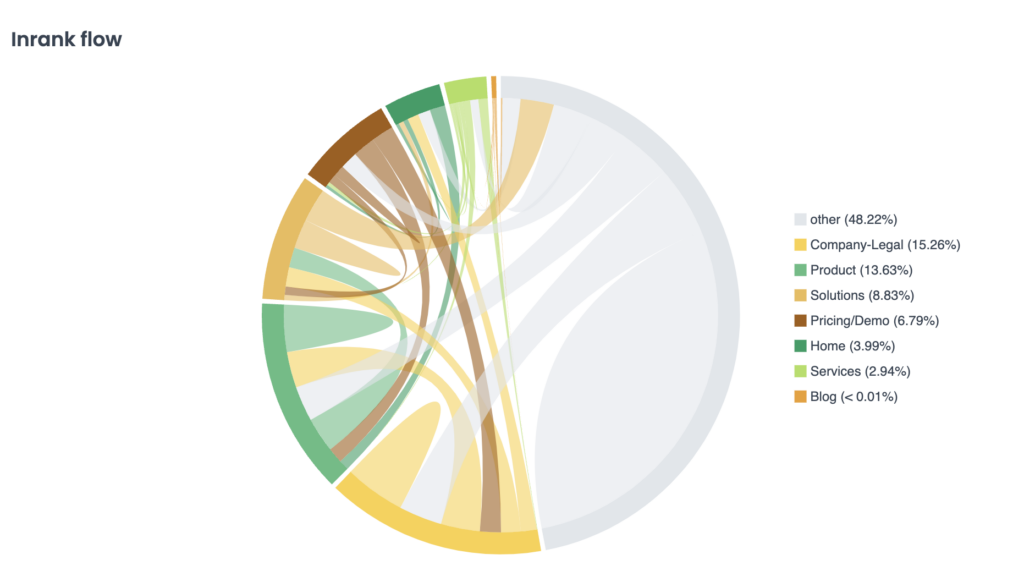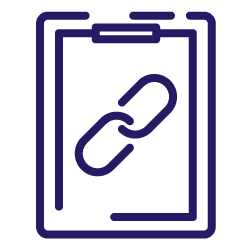An effective internal linking structure is the cornerstone of a well-organized and user-friendly website.
Think of internal links as the secret pathways that tie your website’s content together. They’re like little signposts for both search engines and visitors, helping them navigate through your site smoothly. A well-organized and user-friendly website relies heavily on these connections.
Let’s dig deeper into the fundamentals of internal linking and structure, uncovering their significance for technical SEO and user experience.
The basics of internal linking: The ‘what’ and ‘why’
Whether you’re a website owner, content creator, or digital marketer, a comprehensive understanding of a site’s internal linking structure can maximize the potential of your online presence.
By strategically interconnecting different parts of a website, businesses can enhance the user experience and boost overall site authority.
This navigational framework not only facilitates easy access to relevant information but also establishes contextual relationships between pages, thereby increasing the overall credibility and trustworthiness of the website.
Let’s look at an e-commerce website, for example. Such websites can have hundreds of thousands of pages. With so many options, where do you even start when you’re trying to decide which pages to highlight?
By taking a look at an in-depth internal linking analysis, you can establish a well-thought-out strategy that will not only guide customers to the right pages, but is also essential for crawl optimization (we’ll talk about this more later).
Types of internal links
Not all links are created equal. Before you can thoroughly understand your internal linking structure, it’s useful to look at the types of internal links that exist and how they can impact your SEO efforts.
Contextual links
These are hyperlinks embedded within the body of a page’s content, offering additional resources or related information. The context in which a link appears can often serve to separate a high-value link from a low-value one. You’ll often find contextual links on blogs pointing to other relevant/related articles.
Navigational links
Found in the main menu, sidebar, footer, or other prominent areas of a website’s layout, navigational links are also known as “nav” links. This specific type of hyperlink on a web page allows users to navigate between different sections or pages of a website easily. It is highly recommended to clearly label these links and keep them organized and easily accessible to ensure a seamless browsing experience.
Footer links
Footer links provide supplementary navigation options and are located at the bottom (footer) of a webpage. They serve as a crucial component of any site and typically include navigation links to essential pages, legal information, contact details, sitemaps, social media links, and additional resources.
They help search engines understand the structure of a website as long as they are clear, organized, and distinguishable.
Breadcrumb links
These types of links display the hierarchical path to the current page, aiding users in understanding their location within the site. A form of website navigation found typically at the top of a webpage, they provide users with a clear path back to higher-level pages or categories.
For example, on an e-commerce site, breadcrumbs might display as “Home > Category > Subcategory > Product.”
Breadcrumbs are commonly found on e-commerce, news, and large content-driven websites and can potentially lead to longer on-site engagement, but are not a direct ranking factor.
Anchor text links
Anchor text links are hyperlinks within clickable text that often use descriptive keywords to provide context to the linked page. The clickable text provides a concise description of the linked page’s content, giving users and search engines context about the destination.
Here for instance, the anchor text will lead you to an article that delves deeper into the subject and explains how to create the perfect anchor text to keyword ratio.
Benefits of effective internal linking
Although internal linking may be second nature to seasoned SEO professionals, it’s always a good idea to question and know why you’re doing something. Links and a well defined internal linking strategy offer a certain number of benefits.
- Improved user navigation: Internal links create a seamless browsing experience, allowing users to explore related content effortlessly.
- Enhanced crawling & indexing: Search engines use internal links to crawl and index your site. A well-structured internal linking system can help them understand the context and relevance of your content. There are website SEO checker tools to help you out in your SEO efforts.
- Reduced bounce rate: When users find relevant and engaging content through internal links, they are more likely to stay on your site, reducing bounce rates.
[Ebook] How your internal linking scheme affects Inrank
Understanding your internal linking structure
As we touched on earlier, internal linking involves strategically placing hyperlinks within a website’s content that connect one page to another within the same domain. An intelligently designed internal linking structure clearly lays out the hierarchy and importance of various pages, potentially resulting in higher rankings for key content.
But search engines aside, it’s also important for you to understand how the internal link popularity flows within your website. Oncrawl computes an Inrank score that measures the authority of a page regarding the number and depth of internal links pointing to the page and helps you understand your internal linking strategy and its impact a bit better.

Source: Oncrawl
Let’s take a look at what elements intermingle to create a strong internal linking structure.
Site hierarchy and siloing
Site hierarchy refers to the organization and arrangement of pages within a website and it dictates how different pages are interconnected based on their relative importance and thematic relevance.
Understanding the hierarchical structure of your site helps you guide your users where you ultimately want them to go. It involves organizing content into categories and subcategories, creating a clear path for browsing and crawling.
Siloing, on the other hand, is a method of organizing content based on thematic relevance and topic clusters. Internal links are used to connect pages within a silo, emphasizing the thematic coherence of the content. It helps users find and explore content that is closely related to their interests, providing an opportunity for focused and intuitive navigation.
Anchor text relevance
We’ve looked at the definition of anchor text links, but it’s important to know how to use them effectively. Choosing the right anchor text consists of finding a balance between relevance and natural language. It should provide context about the linked page without being overly optimized.
Different kinds of anchor text exist (branded, topical, miscellaneous…), but there are three key points to make sure you’re doing right. It’s essential that your anchor text is brief, relevant, and includes keywords…but not too many.
Link depth and click depth
Link depth refers to how many clicks it takes for a user to reach a specific page from the homepage. Understanding and managing link depth ensures that important pages are easily accessible.
Shallow link depth ensures quick access to vital content from the homepage, which can enhance your visibility in the SERPs as well as user engagement.
In terms of SEO and crawlability, shallower link depths are favored by search engine crawlers. The graph below shows the impact of depth on the number of times pages in the site structure were crawled by Google per day.

Source: Oncrawl
It’s evident that search engine bots have a tendency to explore the easily accessible pages more frequently. Users are the same. Understanding click depth aids in streamlining navigation and reducing user frustration by minimizing clicks needed to reach specific information.
Best practices for internal linking
Whether you’re building a site from scratch or optimizing one that already exists, here are some best practices that can help you refine your internal linking strategy.
Determine your site’s priority pages
Based on your type of site, your priority pages will change. E-commerce sites, for example, generally place a lot of importance on their category pages. The ephemeral nature of classified and listing sites also leads them to focus more on category pages as opposed to the high number of short-lived pages.
Depending on your objectives, you will have to identify which pages should address the top of your marketing funnel – in this case, generally the more generic pages that address broad keywords which usually have higher search volumes. Next, work on guiding search engines and users to those “money” pages.
Audit your site
Once you know what pages you want to focus on, it’s best to evaluate what already exists (unless it’s a brand-new site) on your site and which pages you’re signaling to be the most important. What you think your priority pages are and what Google actually identifies may be two separate things.
To get that information, perform a crawl and thorough site audit to identify orphaned pages – those without internal links – and ensure a balanced distribution of link equity across your site.
Oncrawl can help you collect such information about your website through its technical SEO crawler. You can discover the technical performance of your site’s pages and determine which ones are more strategically important to leverage for their authority.
On the other hand, you should also identify any orphan pages that may be part of your site.

Source: Oncrawl
Any page – particularly your high priority pages – should be accessible in one way or another from the site navigation.
We won’t go into all the details of what a site audit can unearth, but here are some key questions you should be asking.
- Does your site provide high-quality content that is valuable to users?
- Have you submitted an XML sitemap for efficient discovery of essential pages?
- Are you using a robots.txt file to guide crawlers?
- Does your site prioritize a mobile-friendly design for compatibility with mobile searches?
- How does your site perform in regards to page load speed?
- Are you using clean, descriptive URLs and canonical tags to handle duplicate content?
- Have you crafted relevant meta tags and prioritized HTTPS for security and trust?
- Do your images include descriptive alt text?
Fix issues found in your audit
Your site audit will inevitably reveal one or two areas for improvement. But for the sake of this article, let’s talk about the one’s related to linking.
Did you discover any broken links returning 5xx or 4xx status codes? Is your site currently using temporary redirects during the auditing process? If so, it’s best to fix them as quickly as possible.
Keep tabs on your site by running a crawl on a regular basis and setting up alerts so you can be informed whenever a problem occurs.
Strategically link to key content
Your goal for internal linking should be to purposefully place hyperlinks within your website’s content to direct users and search engines to specific high priority pages. By thoughtfully incorporating links to key content, you ensure that vital pages are easily accessible.
This practice serves to distribute link authority, establish information hierarchy, support SEO efforts and increase conversion opportunities.
Advanced techniques for internal linking optimization
Create hub pages or topic clusters
Create hub pages or topic clusters by grouping related content under a central “hub” or main page for improved user experience and SEO. Hub pages serve as comprehensive resources on specific topics, linking to detailed subtopic content.
Interlinking between the hub and subtopic pages aids navigation. For example, in digital marketing, a hub page on “Digital Marketing Strategies” can link to subtopics like “Content Marketing Tips” and “SEO Best Practices.”
Utilize pagination and pagination links
Pagination is a technique used on websites to break up long content into multiple pages, making it more manageable for users to read. This practice is particularly useful for content-rich websites, such as blogs, forums, or e-commerce platforms, and helps prevent duplicate content issues, as each page is distinct.
Common mistakes to avoid
Where there is a list of best practices, there is also a list of don’ts. Here are some practices to avoid when working on your internal linking structure.
Excessive internal linking: While in terms of SEO, links serve an important purpose – providing search engines with clues about the content and relevance of the linked page – over-optimization is something to be wary about. Focus on providing relevant and valuable links rather than trying to include them excessively.
Generic link text: Avoid generic anchor text like “click here” or “read more.” Using irrelevant anchor text or contextual links can be seen as spammy and potentially harm your site’s authority and consequently your place in the SERPs.
Ignoring mobile optimization: Neglecting to optimize internal links for mobile devices can result in a poor user experience and diminished engagement. Make sure to provide clear, clickable anchor text and adequate spacing to prevent accidental clicks. Implement responsive design for adaptability to various screen sizes, avoiding small fonts or buttons.
Final thoughts
Developing a good SEO strategy takes into account a lot of different moving parts and internal linking is an important one. It plays an essential role in how search engines and users not only view your site but also how they navigate it.
When you methodically connect pages with hyperlinks on your website, you’re signaling to search engines which pages hold the most significance for your business and you’re also creating a roadmap to explain how best to find what they are looking for.
Armed with the tips and best practices above, you’re well on your way to an optimized internal linking structure.

